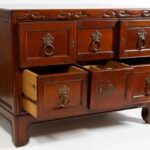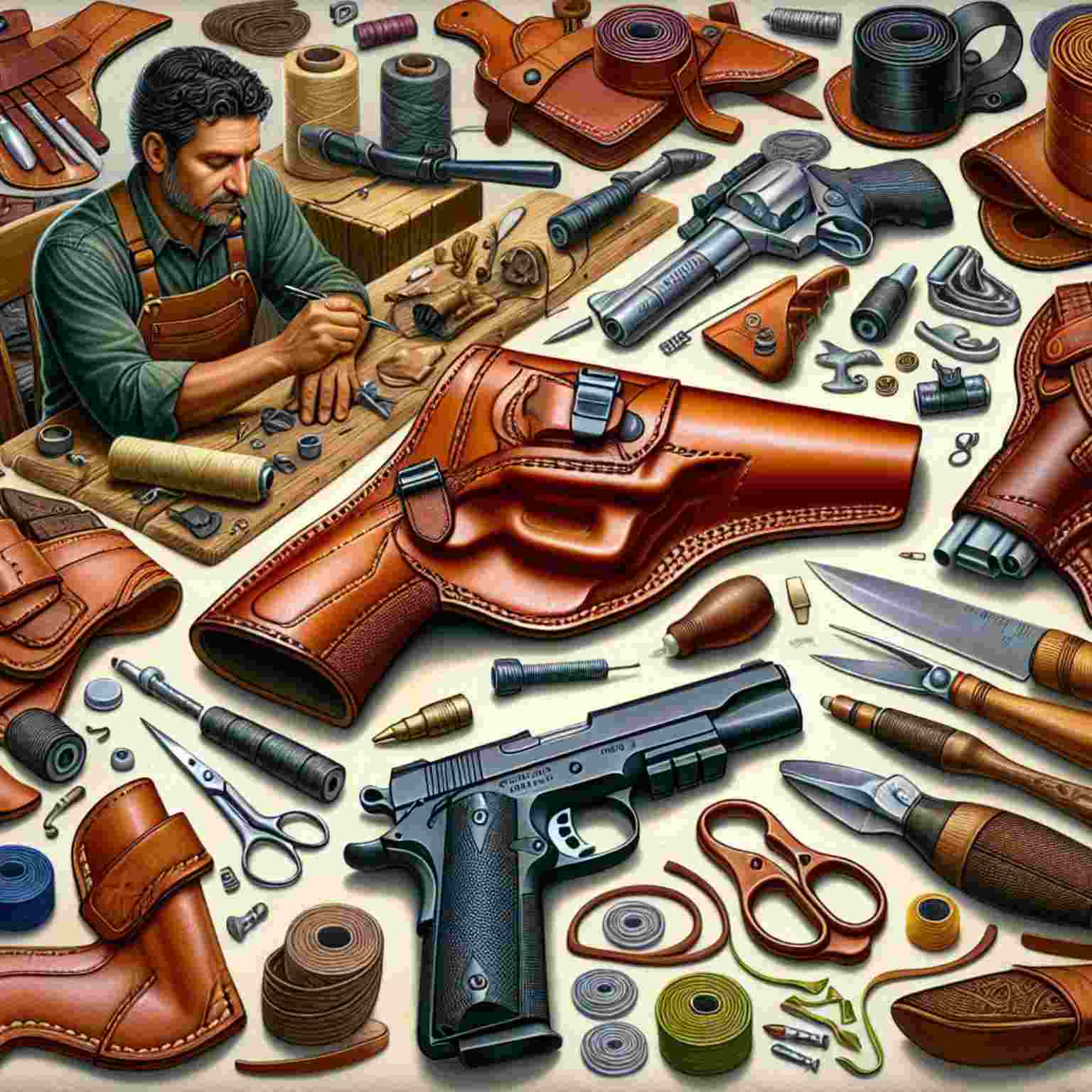Imagine stepping into the wild, your trusted firearm safely nestled at your side, wrapped in a masterpiece of craftsmanship—a leather holster that is both practical and beautiful. Whether you’re a leather crafter eager to hone your skills, a gun enthusiast seeking the perfect accessory, or an outdoor adventurer craving reliability and style, understanding the design and construction of a practical leather holster can open new dimensions of functionality and artistry.
This post will unveil the intricate world of leather holster creation, offering insights into choosing suitable materials, understanding design principles, mastering construction techniques, and maintaining your handcrafted piece. This guide aims to equip you with the knowledge to craft or choose a leather holster that perfectly balances practicality and aesthetic appeal.
The Timeless Appeal of Leather Holsters
The allure of leather in holster design is undeniable. For centuries, leather has been the material of choice for those seeking durability, flexibility, and a touch of elegance in their gear. Its natural beauty and ability to mold to its contents make it the quintessential choice for holsters.
Leather provides a unique combination of strength and adaptability. It can withstand the harshest conditions but feels soft and supple against the skin. The more you use it, the more it molds to the shape of the firearm, offering a custom fit that synthetic materials just can’t match. This adaptability is especially valued by those who spend significant time outdoors.
Furthermore, leather’s aesthetic appeal must be balanced. It ages gracefully, developing a patina that tells a story of adventures and experiences. For leather crafters, each holster is not just a tool but a canvas for creativity and personal expression, transforming a simple accessory into a work of art.
Choosing the Perfect Leather
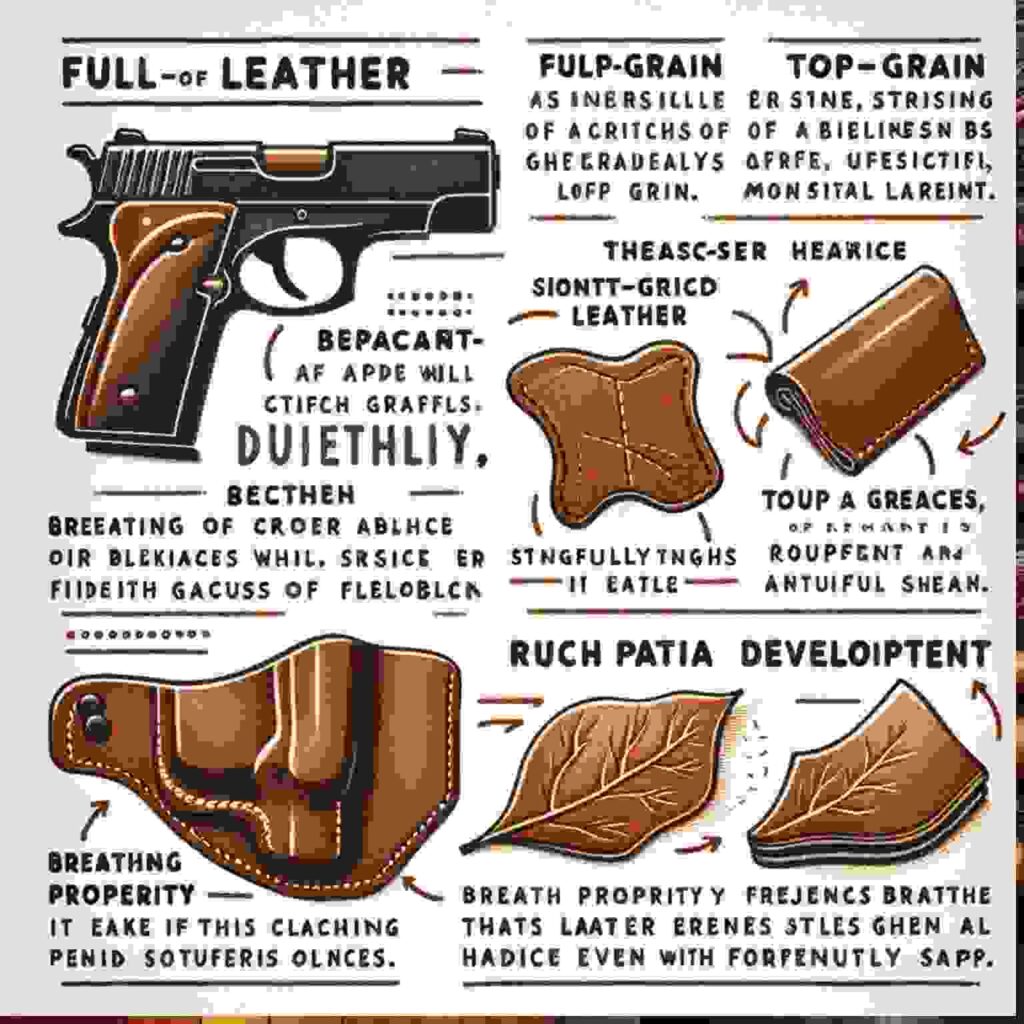
Selecting the right leather is the first step in crafting a practical and durable holster. The type of leather you choose will affect the holster’s appearance, longevity, and functionality.
Full-grain leather is considered the gold standard due to its durability and ability to age beautifully. It retains the hide’s natural grain, offering a tough exterior that withstands scratches and wear. Top-grain leather is an excellent alternative for a softer feel, balancing strength and comfort.
When choosing leather, consider the thickness as well. A thickness of 8-10 ounces is often recommended for holsters, providing the right balance of rigidity and flexibility. This thickness ensures the holster maintains its shape, even with frequent use, while allowing the leather to bend where needed.
Pay attention to the leather’s finish, too. A natural finish allows the leather to breathe and develop a rich patina. However, a coated finish might be preferable for those who prioritize water resistance and ease of cleaning. Your choice of leather should reflect your priorities and the conditions in which the holster will be used.
Designing for Functionality and Style
A practical leather holster must marry functionality with style. The design process carefully considers the user’s needs—comfort, accessibility, and security are paramount concerns.
Start by considering the carrying position. Whether the user prefers an inside-the-waistband (IWB) carry for concealment or an outside-the-waistband (OWB) carry for ease of draw, the design must support those preferences. The holster must position the firearm at the correct angle and height to facilitate a smooth, quick draw.
Retention is another crucial aspect of design. The holster should securely hold the firearm in place, even during vigorous activity, while allowing easy access when needed. This balance can be achieved through design elements such as adjustable retention screws or thumb breaks.
Aesthetics should be noticed. The design should reflect the user’s style, whether through intricate tooling, stitching patterns, or color choices. These details can transform a practical piece into a statement accessory, showcasing the skill and creativity of the leather crafter.
Tools of the Trade
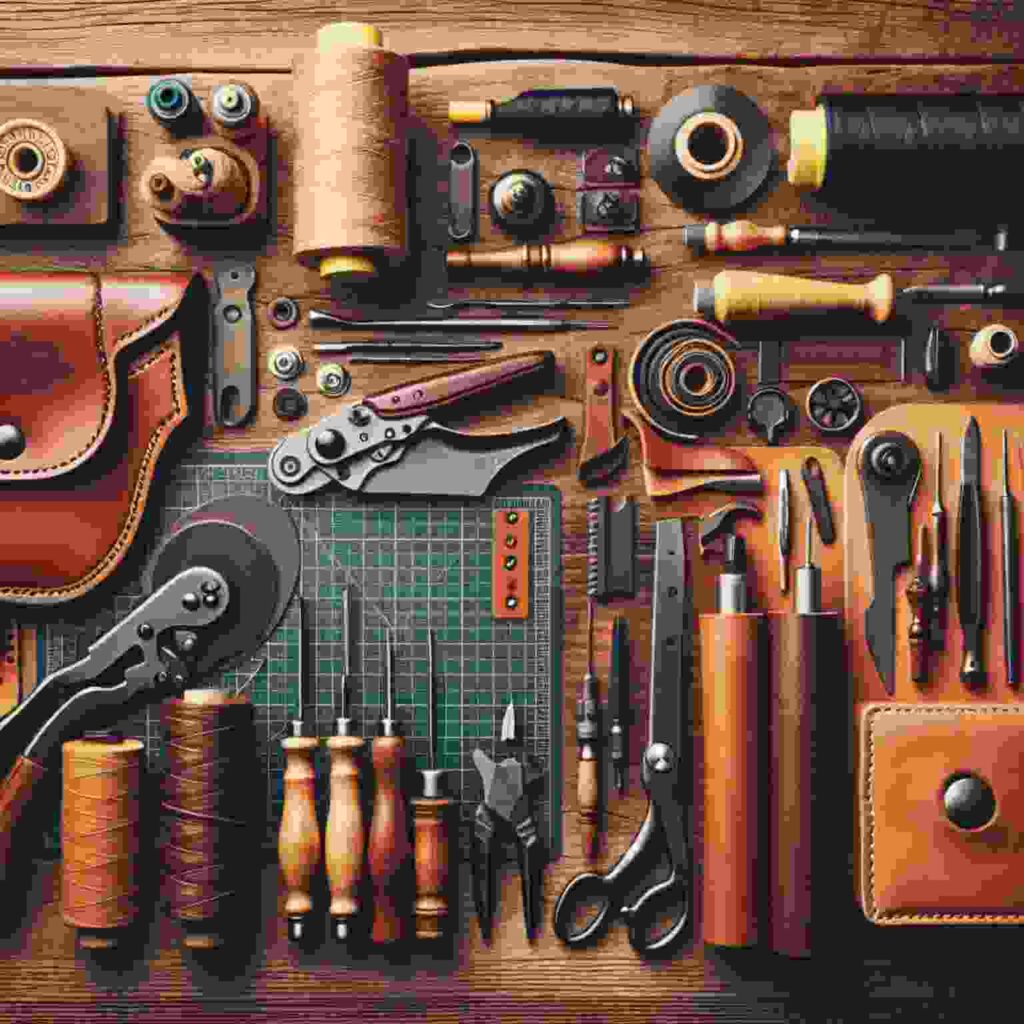
Creating a leather holster requires specific tools that enable precision and durability in construction. Investing in quality tools for those new to leather crafting is essential for achieving professional results.
A rotary cutter or sharp knife is necessary for cutting leather with clean, straight edges. A sturdy cutting mat protects surfaces while allowing for smooth, accurate cuts. Tools such as edge bevelers, stitching groovers, and hole punches are invaluable for shaping and detailing.
Stitching is a crucial aspect of holster construction, and a solid stitching setup is critical. An awl helps create neat, even holes for stitching, while waxed thread and needles ensure solid, long-lasting seams. A stitching pony or clam can hold the leather securely while you work, freeing your hands for precise stitching.
Lastly, finishing tools such as burnishers, edge slickers, and leather conditioners help refine the final product, giving it a polished, professional look and feel. With the right tools, crafting a leather holster becomes rewarding and creative.
Mastering Holster Construction
Constructing a leather holster involves several steps that require precision and patience. From cutting and shaping to stitching and finishing, each phase demands attention to detail to ensure a functional and aesthetically pleasing product.
Begin by cutting the leather according to your design pattern. Accuracy is crucial here, as any deviation can affect the holster’s fit and finish. Once cut, shape the leather by molding it around a replica firearm, using water to soften it and allow it to take the desired form.
Stitching is the next critical step. Use a saddle stitch technique for strength and durability, ensuring each stitch is even and tight. This technique involves stitching both sides of the seam simultaneously, creating a robust bond that withstands daily use.
Finally, finish the edges and apply a leather conditioner to enhance the holster’s appearance and longevity. Burnishing the edges smooths them out, providing a professional finish, while conditioning keeps the leather supple and resistant to the elements.
Personalizing Your Holster

One of the joys of leather crafting is the ability to personalize each piece, creating a holster that reflects the user’s personality and style. Personalization can enhance both the aesthetic appeal and sentimental value of the holster.
Consider adding decorative elements such as tooling, embossing, or custom stitching. These techniques can transform a simple holster into a unique piece of art. Stamping initials or a personal emblem also adds a touch of individuality.
Coloring is another way to personalize a holster. Dyes and finishes allow you to achieve a range of hues, from classic browns to vibrant reds or blues. Experiment with antiquing or layering colors to create depth and texture.
Personalization enhances the holster’s visual appeal and connects the user more deeply to their gear. Each unique detail serves as a reminder of the craftsmanship and thought that went into creating the piece.
Ensuring Safety and Compliance
Safety and compliance should always be top priorities when crafting or using a leather holster. A well-designed holster enhances performance and ensures firearms’ safe handling and carrying.
Ensure that the holster provides adequate trigger guard coverage, preventing accidental discharge. The design should also allow for a secure fit, minimizing the risk of the firearm slipping out unexpectedly. Retention features such as tension screws or straps are essential for safety, especially during active use.
Compliance with local laws and regulations is equally important. Be aware of any legal requirements regarding holster design and materials and carry positions in your area. Staying informed will help you craft or choose a holster that meets all necessary standards.
By prioritizing safety and compliance, you can confidently enjoy the benefits of a leather holster, knowing it is both functional and secure.
Maintaining Your Leather Holster
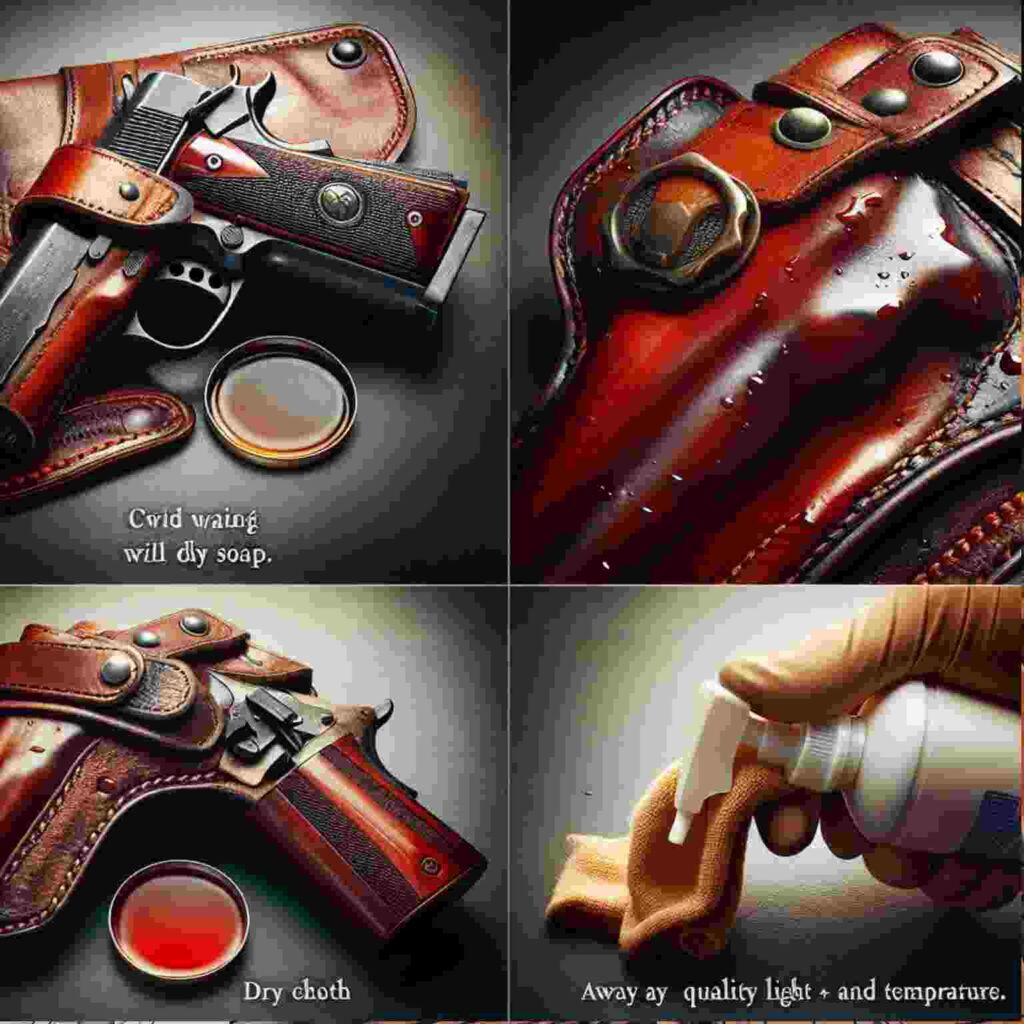
Proper maintenance is essential for preserving the beauty and functionality of a leather holster over time. With regular care, a well-crafted holster can last for years, developing a rich patina that adds character and charm.
Regularly clean the holster to remove dirt and debris. Use a damp cloth and mild soap to gently wipe the surface, followed by a dry cloth to remove excess moisture. Avoid soaking the leather, as excessive water can cause it to become stiff and brittle.
Condition the leather periodically to keep it supple and resistant to cracking. Choose a quality leather conditioner, apply it with a soft cloth, and allow it to penetrate the leather before buffing away any excess.
Store the holster in a cool, dry place away from direct sunlight and extreme temperatures. Proper storage prevents warping and fading, ensuring the holster retains its shape and color over time.
Exploring New Frontiers in Holster Design
The world of leather holster crafting is constantly evolving, with new techniques and materials offering exciting possibilities for innovation and creativity. Staying informed about industry trends can inspire fresh ideas and enhance your skills as a leather crafter.
Consider experimenting with modern materials such as hybrid designs that combine leather with Kydex or other synthetics. These materials offer unique advantages, such as increased rigidity and reduced weight, while maintaining the classic appeal of leather.
Advanced tooling and embossing techniques can add depth and complexity to your designs. Explore new patterns and textures, incorporating elements such as laser engraving or 3D printing to push the boundaries of traditional leather crafting.
By staying open to new ideas and techniques, you can continue to refine your craft and create innovative and timeless holsters, meeting the diverse needs of today’s users.
Resources for Aspiring Leather Crafters
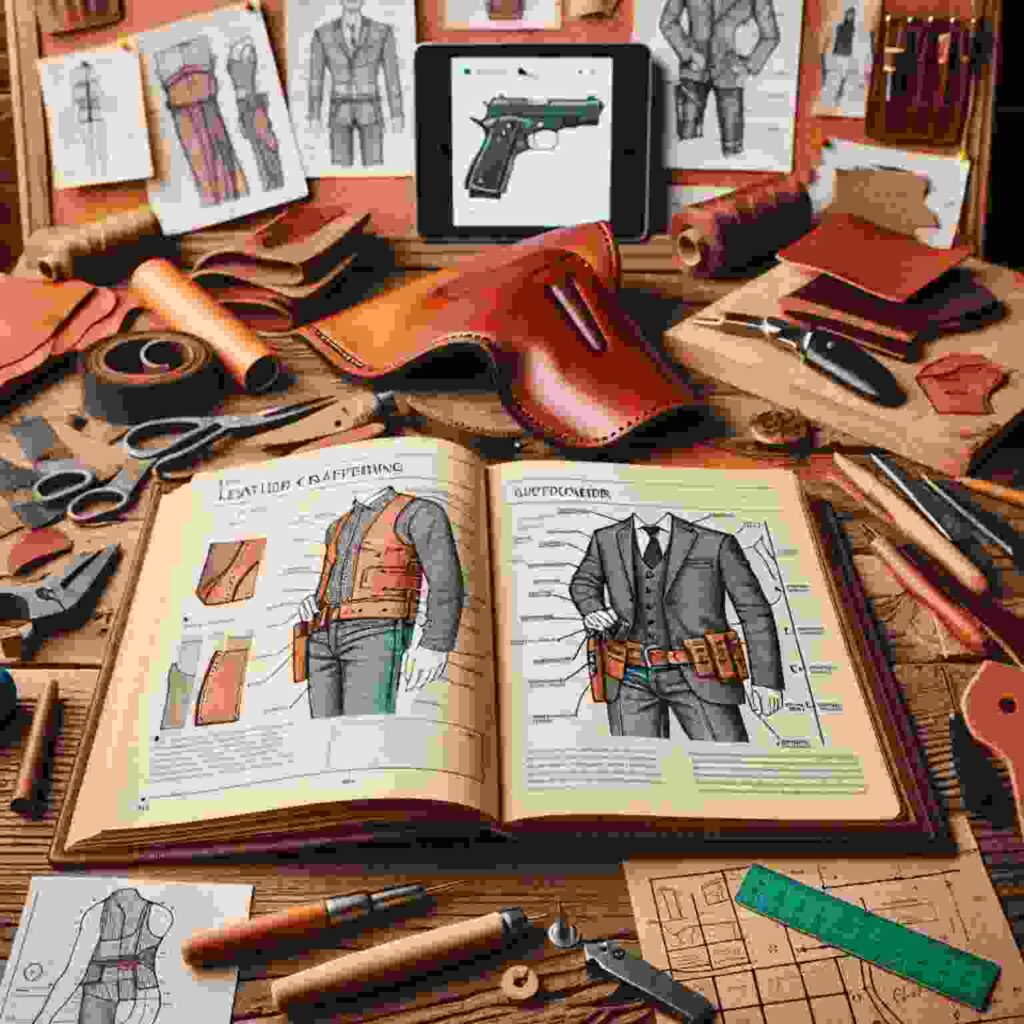
Numerous resources are available to support your learning and development, whether you’re a beginner or an experienced crafter. These resources can provide valuable insights and inspiration for those interested in further exploring the art of leather holster crafting.
Online tutorials and courses offer step-by-step guidance on various aspects of leather crafting, from basic techniques to advanced design concepts. Platforms such as YouTube, Skillshare, and Udemy feature a wealth of content created by experienced artisans.
Books and magazines dedicated to leatherworking provide in-depth knowledge and practical tips. Titles such as “The Leatherworking Handbook” by Valerie Michael and “Leathercraft” by Nigel Armitage are excellent starting points for those looking to expand their skills.
Joining a community of leather crafters can also be beneficial. Online forums and social media groups provide opportunities to connect with fellow enthusiasts, share experiences, and seek advice from seasoned professionals.
Elevate Your Craft with Expert Guidance
Crafting a practical and beautiful leather holster is both an art and a science. You can create a piece with a functional accessory and a personal style statement with suitable materials, tools, and techniques.
For those seeking personalized guidance and support, consulting with experienced leather crafters or enrolling in mentorship programs can provide valuable insights and feedback. A mentor can help refine your skills, troubleshoot challenges, and achieve your creative vision.
Whether crafting for personal use or starting a business, expert guidance can elevate your craft and open new opportunities for growth and success in the leatherworking world.
Conclusion
The design and construction of a practical leather holster offer a rewarding blend of creativity and functionality. By understanding the materials, techniques, and design principles, leather crafters, gun enthusiasts, and outdoor adventurers can create or select holsters that meet their unique needs and preferences.
This guide has explored the timeless appeal of leather, the steps involved in crafting a holster, and the importance of personalization, safety, and maintenance. With these insights, you are well-equipped to embark on your leather crafting journey or enhance your appreciation for these exquisite creations.
For those eager to learn more, consider enrolling in courses, joining communities, or seeking mentorship from experienced artisans. With dedication and practice, you can master the art of leather holster crafting and enjoy the satisfaction of creating a piece that is as practical as beautiful.

